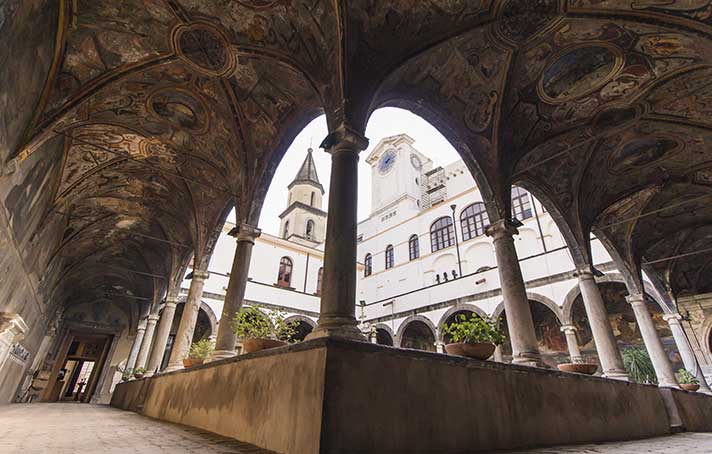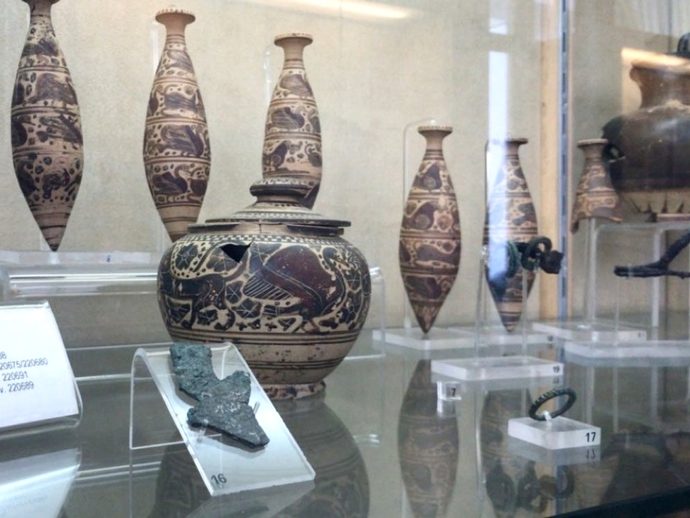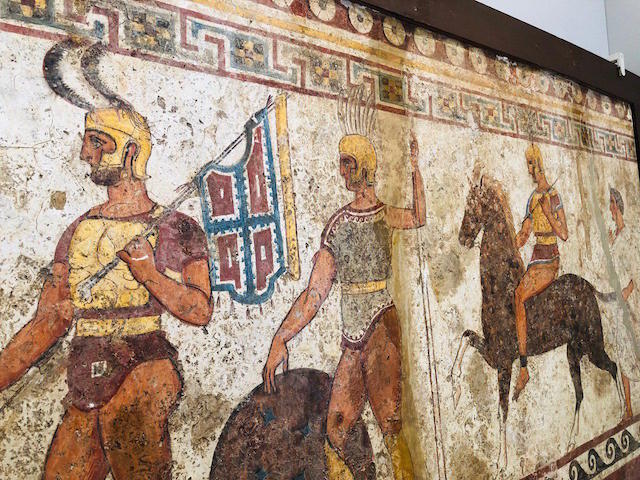



The Archaeological Historical Museum is housed in the monastic complex of Santa Maria la Nova, built in 1521 in the medieval Casale Nuovo della Nola.

The initial nucleus, inaugurated in the summer of 2000 with the aim of preserving and enhancing the archaeological and historical-artistic heritage of the city and the surrounding area, was enriched, in December 2009, with finds from new excavations and materials of medieval and modern age.

The museum exhibition aims to tell the chronological development of Ager Nolanus through a path that unfolds over three floors, bringing together old finds with those from recent excavations promoted by the Special Superintendence for Archaeological Heritage of Naples and Pompeii. What is visible in the display cases reflects some aspects of the millenary life of the Agro Nola area, from the most ancient testimonies of the Bronze Age to the paintings of the modern age.

The first three rooms on the ground floor are dedicated to the prehistoric section. In it the findings of the facies of Palma Campania are flanked by experimental reconstructions such as the physiognomy of the faces of three buried in the necropolis of San Paolo Belsito and the reconstruction, in the hall of the former refectory, of one of the three huts of the Pope's Village of Croce di Nola, with the finds found in it.
In the next room the story continues with the exhibition of the funerary objects from the Orientalizing period. In the second half of the eighth century. B.C. the indigenous team began to organize itself into a community and to give life to a settlement with a distinct division of spaces. The oldest burials, in fact, coming from the Torricelle necropolis which develops north-east of the city, date back to between the end of the eighth and the beginning of the seventh century. B.C..

Continuing with the visit, the social changes that have taken place within the community can be observed through the composition of the kits. To the vases of local impasto and to the refined ornaments in amber, silver and gold foil present in the furnishings of the end of the eighth century. B.C., they are immediately associated with purified clay pots imported from Cumana or produced in Daunia. This underlines the role of an important commercial crossroads that Nola has played since its origins.
In fact, between the end of the seventh and sixth centuries BC, the indigenous settlement was transformed into a real city. The impetus of the cities founded by the Etruscans, and in the first place of nearby Capua, was decisive in this urbanization process, as confirmed by the conspicuous presence of bucchero, Etruscan-Corinthian ceramics and the use of writing in some graffiti inscriptions on vases.
In the 6th and 5th centuries BC Nola lived a moment of maximum splendor and did not seem to feel the shocks due to the decline of the Etruscan dominion in Campania. The foundation of Neapolis in 470 BC gave the city a golden age of commerce and trade as reflected in the funerary objects, composed of precious Attic vases with black and red figures. During the fifth century. to. C. in imitation of Greek red-figure pottery develops a local production called the Pilaster with the owl of which Nola must have been one of the production centers. In the fourth century. C.
We are witnessing the formation of a profoundly Hellenized ruling class dedicated to war which entrusts its ideological expression to funerary painting as shown by the heroised portrait of a knight with a horned helmet, depicted on a slab of a semi-chamber tomb found in 1977 in via Seminary . The other painted slabs, exhibited in the corridor that flanks the courtyard, come one from the Ronga necropolis, one from the necropolis in via san Massi-mo and three from a settlement north-east of the city in the Masseria Sarnella di Casamarciano.

The fourth century BC, however, also marks the beginning of the Roman penetration into Campania from which not even Nola will be able to escape. After several attempts at resistance, the city in 313 BC. is forced to capitulate. From 89 to 87 BC Nola was besieged by Silla who finally conquered it in 80. The deduction of the colony of veterans by the Roman general altered the layout of the city with the construction of new public monuments. The amphitheater was built on the rubble of the Samnite quarter, to which the six limestone pillars with relief decoration displayed in the corridor in front of the stairs belong. The main streets were flanked by a series of funerary monuments, adorned with metopes and statues such as those in limestone depicting togates, found in the locality of Cangio and the two statues depicting Attis from a funerary monument in Cicciano. The subsequent deductions of colonies by Augustus, Vespasian and Nerva further enriched the city with public monuments and new temples. On the landing of the staircase that leads to the first floor, you can admire an imposing statue of Lorica from the Trajan period. The exhibition of the super floor
iore opens with a beautiful mosaic fountain with a Nilotic landscape, dated to the beginning of the third century. A.D., coming from a villa that insisted on today's Via San Paolo Belsito. This villa was part of those luxurious private homes that occupied the Nola area in Roman times. The Roman age ends with a space dedicated to the villa found in the locality of Starza della Regina in Somma Vesuviana and the subject of excavation since 2002 by the University of Tokyo. In the center of the room, in fact, stand the two statues found in 2003, one of the god Dionysus with his head crowned with ivy and a panther cub in his arms and one of a woman with a Greek dress (peplos). On the back wall of the corridor on the first floor, then, we find finds from the early Christian period: two fragments of marble pluteus and four marble pillars forming part of the presbytery of the Basilica of San Felice of the basilica complex of Cimitile, dated between the end of the 9th and the beginning of the 10th century. d. C .. The section is enriched by two of the funerary objects of the twenty-six burials found during the excavations at the Basilica of Tufino.
The room dedicated to the Renaissance, which opens with the display of finds from the excavations of Palazzo Orsini, houses the polychrome marbles with inserts of mother-of-pearl, lapis lazuli and semiprecious stones from the altar of the Church of Santa Maria La Nova. In the same room you can admire a table with the Annunciation by Giovanni Angelo D'Amato and an Immaculate Conception recently attributed to Giovanni Andrea Taurella, both dated to the end of the 16th century.
The exhibition on the first floor ends in a large hall in which on the back wall stands the Annunciation made in the second twenty years of the 1700s by Domenico Antonio Vaccaro for the church of Santa Maria del Plesco in Casamarciano. Finally, the mezzanine floor houses a collection of almost 1000 Neapolitan riggiole and ceramics ranging from the 15th century to the present day, coming from the private collection of Diodato Colonnese.

The Historical-Archaeological Museum of Nola is open every day except Monday.
Free entry.
Archaeological Historical Museum of Nola
Address: Via Senatore Cocozza, 1 Nola
Phone: 081 5127184
Site:
http://cir.campania.beniculturali.it/museonola/Location inserted by
Annalisa Giordano